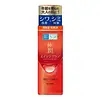Hada Labo Gokujyun Aging Care Firming Lotion Versus Hada Labo Kouji Tightening & Hydrating Gel Emulsion
What's inside
What's inside
 Key Ingredients
Key Ingredients

 Benefits
Benefits

 Ingredients Side-by-side
Ingredients Side-by-side

Niacinamide
SmoothingSodium Hyaluronate
HumectantHydrolyzed Hyaluronic Acid
HumectantSodium Acetylated Hyaluronate
HumectantAcetyl Glucosamine
Skin ConditioningSorbus Aucuparia Fruit Extract
Skin ConditioningButylene Glycol
HumectantGlycerin
HumectantPentylene Glycol
Skin ConditioningPEG-30 Dipolyhydroxystearate
EmulsifyingPPG-13-Decyltetradeceth-24
EmulsifyingBeheneth-30
CleansingLimnanthes Alba Seed Oil
Skin ConditioningCarbomer
Emulsion StabilisingTriethanolamine
BufferingEDTA
Hydroxyethylcellulose
Emulsion StabilisingPhenoxyethanol
PreservativeNiacinamide, Sodium Hyaluronate, Hydrolyzed Hyaluronic Acid, Sodium Acetylated Hyaluronate, Acetyl Glucosamine, Sorbus Aucuparia Fruit Extract, Butylene Glycol, Glycerin, Pentylene Glycol, PEG-30 Dipolyhydroxystearate, PPG-13-Decyltetradeceth-24, Beheneth-30, Limnanthes Alba Seed Oil, Carbomer, Triethanolamine, EDTA, Hydroxyethylcellulose, Phenoxyethanol
Water
Skin ConditioningButylene Glycol
HumectantGlycerin
HumectantHydrogenated Poly(C6-12 Olefin)
Skin ConditioningPentylene Glycol
Skin ConditioningSimmondsia Chinensis Seed Oil
EmollientCaprylic/Capric Triglyceride
MaskingRice Ferment Filtrate
Skin Conditioning1,2-Hexanediol
Skin ConditioningPEG-20 Sorbitan Isostearate
EmulsifyingHydroxyethyl Urea
HumectantSodium Acrylate/Sodium Acryloyldimethyl Taurate Copolymer
Emulsion StabilisingGlyceryl Stearate
EmollientSqualane
EmollientArginine
MaskingGellan Gum
Acrylates/C10-30 Alkyl Acrylate Crosspolymer
Emulsion StabilisingPolysorbate 60
EmulsifyingPolyquaternium-51
Skin ConditioningDisodium EDTA
Hydrolyzed Soy Protein
HumectantLactobacillus/Rice Ferment
Skin ConditioningMaltitol
HumectantSodium Hyaluronate
HumectantCyclodextrin
AbsorbentHydrolyzed Rice Protein
Skin ConditioningHydrolyzed Rice Extract
Skin ConditioningHydrolyzed Rice Leaf Extract
AntioxidantWater, Butylene Glycol, Glycerin, Hydrogenated Poly(C6-12 Olefin), Pentylene Glycol, Simmondsia Chinensis Seed Oil, Caprylic/Capric Triglyceride, Rice Ferment Filtrate, 1,2-Hexanediol, PEG-20 Sorbitan Isostearate, Hydroxyethyl Urea, Sodium Acrylate/Sodium Acryloyldimethyl Taurate Copolymer, Glyceryl Stearate, Squalane, Arginine, Gellan Gum, Acrylates/C10-30 Alkyl Acrylate Crosspolymer, Polysorbate 60, Polyquaternium-51, Disodium EDTA, Hydrolyzed Soy Protein, Lactobacillus/Rice Ferment, Maltitol, Sodium Hyaluronate, Cyclodextrin, Hydrolyzed Rice Protein, Hydrolyzed Rice Extract, Hydrolyzed Rice Leaf Extract
 Reviews
Reviews

Ingredients Explained
These ingredients are found in both products.
Ingredients higher up in an ingredient list are typically present in a larger amount.
Butylene Glycol (or BG) is used within cosmetic products for a few different reasons:
Overall, Butylene Glycol is a safe and well-rounded ingredient that works well with other ingredients.
Though this ingredient works well with most skin types, some people with sensitive skin may experience a reaction such as allergic rashes, closed comedones, or itchiness.
Learn more about Butylene GlycolGlycerin is already naturally found in your skin. It helps moisturize and protect your skin.
A study from 2016 found glycerin to be more effective as a humectant than AHAs and hyaluronic acid.
As a humectant, it helps the skin stay hydrated by pulling moisture to your skin. The low molecular weight of glycerin allows it to pull moisture into the deeper layers of your skin.
Hydrated skin improves your skin barrier; Your skin barrier helps protect against irritants and bacteria.
Glycerin has also been found to have antimicrobial and antiviral properties. Due to these properties, glycerin is often used in wound and burn treatments.
In cosmetics, glycerin is usually derived from plants such as soybean or palm. However, it can also be sourced from animals, such as tallow or animal fat.
This ingredient is organic, colorless, odorless, and non-toxic.
Glycerin is the name for this ingredient in American English. British English uses Glycerol/Glycerine.
Learn more about GlycerinPentylene glycol is typically used within a product to thicken it. It also adds a smooth, soft, and moisturizing feel to the product. It is naturally found in plants such as sugar beets.
The hydrophilic trait of Pentylene Glycol makes it a humectant. As a humectant, Pentylene Glycol helps draw moisture from the air to your skin. This can help keep your skin hydrated.
This property also makes Pentylene Glycol a great texture enhancer. It can also help thicken or stabilize a product.
Pentylene Glycol also acts as a mild preservative and helps to keep a product microbe-free.
Some people may experience mild eye and skin irritation from Pentylene Glycol. We always recommend speaking with a professional about using this ingredient in your routine.
Pentylene Glycol has a low molecular weight and is part of the 1,2-glycol family.
Learn more about Pentylene GlycolSodium Hyaluronate is hyaluronic acid's salt form. It is commonly derived from the sodium salt of hyaluronic acid.
Like hyaluronic acid, it is great at holding water and acts as a humectant. This makes it a great skin hydrating ingredient.
Sodium Hyaluronate is naturally occurring in our bodies and is mostly found in eye fluid and joints.
These are some other common types of Hyaluronic Acid:
Learn more about Sodium Hyaluronate